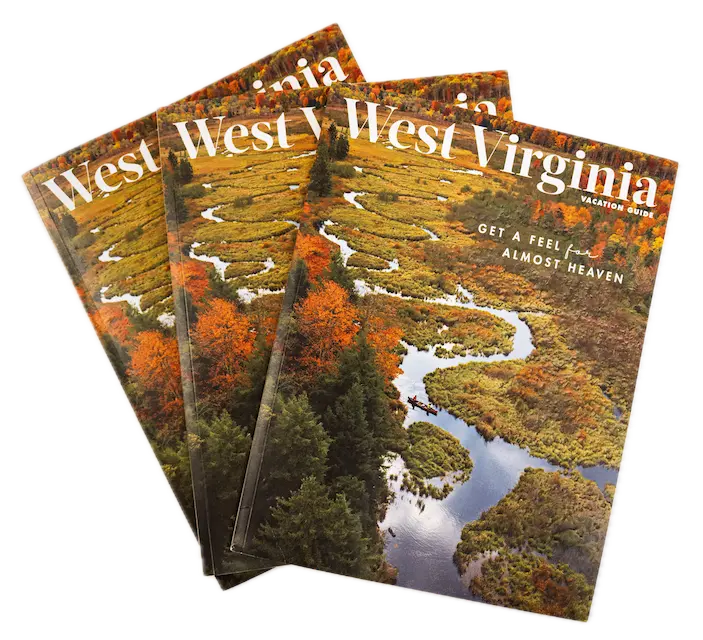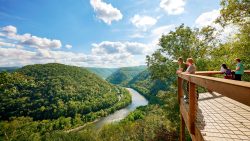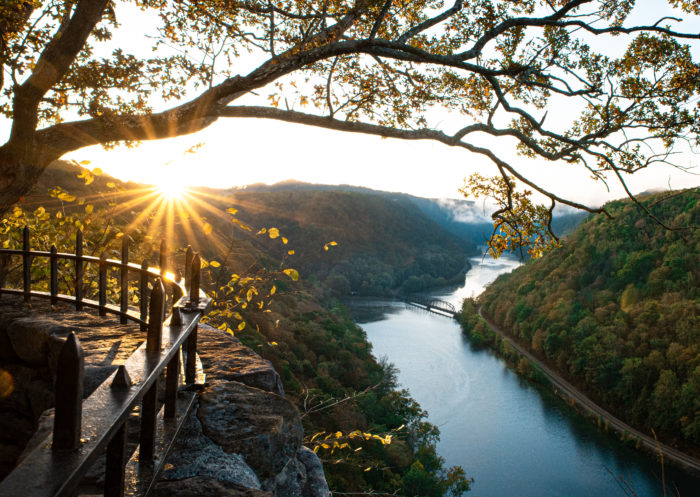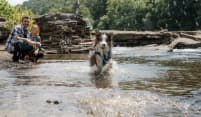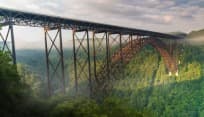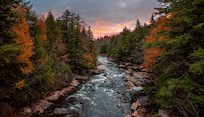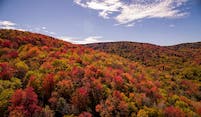Pirate Day – “Secrets of the Dead: Blackbeard’s Lost Ship”
We will be showing a film about the pirate know as Blackbeard, "Secrets of the Dead: Blackbeard’s Lost Ship” (60 min). The most infamous pirate of his day, Blackbeard inspired fear in all who crossed his path. 300 years later, his flag ship, the Queen Anne’s Revenge, is being excavated by a group of marine archaeologists. His story is revealed by careful preservation and analysis of the ship’s remains, including cannons, guns, anchors, and even gold. Did you know that the Upper Ohio River Valley was plagued by pirates as well? See the front of this flyer for “Pirate Day” activities held today.
“The Mine Wars”
In the beginning of the 20th Century, coal fueled industrial progress. Coal mining was an industry in which nearly 750,000 men across the U.S. spent 10 to 12 hours a day blasting, shoveling, and loading the fuel that made the nation’s industrial progress possible. This film brings to life the decades-long struggle for the miner’s right to organize and join a union, and shows how the coalfields of southern West Virginia became a war zone.
Annual Planting of the Interpretive Garden
Help plant the garden and learn about the Three Sisters (corn, beans, and squash) who were planted together in many Native American gardens. There are also indoor activities – the program will take place rain or shine.
Lecture – “Hopewell Geometry, Astronomy, and the Marietta Earthworks”
By Wesley Clarke, MA, RPA - The Castle Museum in Marietta, OH. The earthworks at Marietta, Ohio, includes several unusual features, as well as astronomical alignments. While systematic examination of this site has been limited, research during the past 25 years has added substantially to the site record, pointing to future avenues of inquiry and explanation. Mr. Clarke is currently the resident archaeologist and Manager of Collections at The Castle Museum in Marietta, Ohio, where he is directing excavation of an early nineteenth century pottery production site on the museum grounds.
Lecture – “Early Native Americans in West Virginia: The Fort Ancient Culture”
Based on research for her book, Darla I. Spencer, Author and Registered Professional Archaeologist (RPA), of the same title, Ms. Spencer will present an illustrated summary of what is currently known about the Fort Ancient people in West Virginia. A book signing will follow the lecture.
Lecture – “Beneath the Poppies and Crosses: What Archaeology Reveals about the First World War”
By Hank Lutton, Curator, Grave Creek Mound Archaeological Complex. April 2017 marks the centenary of the United States’ entry into the First World War. To observe the anniversary, this program examines the recent contributions that archaeology has made to better understand “the war to end all wars.” By highlighting battlefield excavations, personal artifacts, and the forensic analysis of the fallen from unmarked graves, this lecture will reveal recent discoveries that are transforming our knowledge of how individual soldiers lived and died a century ago.
Lecture – “Survey and Documentation of Hampshire County Cemeteries”
Lecture – “Survey and Documentation of Hampshire County Cemeteries” By Jamie Vosvick, West Virginia Office Manager & Supervising Archaeologist, Archaeological Consultants of the Midwest, Inc., focuses on how community involvement was instrumental in identifying cemeteries that have been forgotten and/or destroyed and are in danger of being lost. Find out how to save and protect these historic resources.
Petroglyph Postcards
Prehistoric drawings engraved in stone have been found throughout West Virginia. Children find inspiration in the museum's exhibits to make their own petroglyph designs.
“Lewis and Clark: The Eastern Legacy” Film
“Lewis and Clark: The Eastern Legacy” Film Showing at Grave Creek Mound Archaeological Complex, The Grave Creek Mound Archaeological Complex will kick off its 2017 Lecture and Film Series at 7 p.m. on Thursday, January 26, with a showing of the film “Lewis and Clark: Eastern Legacy.” The film follows Lewis and Clark on their epic journey and features West Virginia locations such as Harpers Ferry, where Lewis picked up equipment; Wellsburg, where Patrick Gass, the oldest surviving expedition member, is buried; Wheeling, where a red pirogue and additional supplies were added; and Grave Creek Mound. Lewis visited these locations on his way to meet Clark at the Falls of the Ohio, from where the expedition headed west. Lewis’ description of Grave Creek Mound will be read after the film. The 20-minute documentary was produced by the U.S. Army Corps of Engineers, Great Lakes and Ohio River Division. The program is held in conjunction with the monthly meeting of the Upper Ohio Valley Chapter of the West Virginia Archeological Society.
Native American Heritage Month Lecture: The Trail of Tears Experience of Ohio’s Iroquois
Christopher B. Chaney, Unit Chief, Criminal Justice Information Law Unit, FBI Office of the General Counsel Mr. Chaney is a member of the Seneca-Cayuga Nation from Oklahoma who currently resides in West Virginia. In 1832, Seneca and Shawnee tribal members living in Ohio were forcibly removed from their homes and faced deprivation and death on the Trail of Tears. Upon arrival in Indian Territory (now Oklahoma), the tribal members forged a new way of life only to find their dreams shattered by the Civil War. Key to the survival of the Seneca-Cayuga Nation during this tumultuous time was Quashacaugh, also known as Lewis Davis, who is Mr. Chaney’s great- great-grandfather.
Annual Meeting of the West Virginia Archeological Society
Each year, archaeologists working throughout the state of West Virginia report their latest findings at the annual meeting of the West Virginia Archeological Society (WVAS). Includes a book signing of “Early Native Americans in West Virginia: the Fort Ancient Culture” by Darla Spencer. Registration begins at 8:00 am and the presentations will continue into the afternoon. Non-members are welcome. Cost is $7 for WVAS members, $10 for non-members, and $5 for students. Pre-registration is recommended but not required – please contact Darla Spencer, WVAS Secretary/Treasurer at 304-561-4753 or dispencer@suddenlink.net.
Featured Artist: Eric Dye
The Grave Creek Mound Archaeological Complex, located at 801 Jefferson Avenue in Moundsville, is pleased to host the work of local artist Eric Dye throughout the month of November. Dye, a native West Virginian, graduated from Concord University in 1974 with a Bachelor of Fine Arts, winning several Best of Show awards in various state and regional exhibitions while a student. Dye served as an artist-in-residence in Harpers Ferry after graduation, followed by an artist-in-residency at his alma mater. While there, he carved a nine-ton Bicentennial statue of the first settlers in Mercer County, West Virginia, which now resides on the Courthouse lawn in Princeton, West Virginia. He also carved a portrait bust of Aristotle in early Greek style. During this time, he was also a resource person to students enrolled in art degree programs at Concord. He also studied painting and sculpture at Lyme Academy of Fine Art in Old Lyme Connecticut, under Elisabeth Gordon Chandler and Robert Brackman, both artists of international renown, and members of the National Academy of Design. Since arriving in the Ohio Valley, Dye has participated annually in the Paint Historic Wheeling Plein Air event and has also been a contributor in several of the Cross Currents Art Shows held by the Stifel Museum. Dye works in oils, water color, pastels, charcoal and pencil, as well as carving in stone, wood and bone ivory. He has spent the last 15 years teaching graphic arts through the West Virginia Department of Education, while earning a Masters of Education degree in Education. He now offers private and group lessons in his home studio in Moundsville. An opening reception for Dye’s work will be held on Saturday, November 5, at the Grave Creek Mound Archaeological Complex in Moundsville from 2-5 p.m. Dye’s work will be on display to the public throughout the entire month of November.
We Shall Remain: After the Mayflower
See the “First Thanksgiving” through Native American eyes in this episode of American Experience produced by PBS.
WV Archaeology Month Program: Plantation Archaeology, Industrial Slavery and the Glenwood Project
Robert Maslowski , Retired Archeologist, U.S. Army Corps of Engineers, Huntington District Slave-based agriculture and the salt industry were two of the most important economic pursuits in the early history of West Virginia. The treatment of the enslaved workers differed greatly because slaves in the salt trade were leased instead of owned directly. These differences are revealed in excavations at the Jenkins Plantation on the Ohio River, the Reynolds home and slave cabin at the Marmet Lock Replacement project, and the Glenwood Estate in Charleston, WV.
Historic Ohio Valley Ghost Tales
Storyteller Rich Knoblich tells tales of mystery and suspense centered around the lower Wheeling District and into Marshall County. Knoblich has won multiple Liars Contest awards at the Vandalia Festival held each spring in Charleston by the West Virginia Division of Culture and History.
Historic Ohio Valley Ghost Tales
Storyteller Rich Knoblich tells tales of mystery and suspense centered around the lower Wheeling District and into Marshall County. Knoblich has won multiple Liars Contest awards at the Vandalia Festival held each spring in Charleston by the West Virginia Division of Culture and History.
Plantation Archaeology, Industrial Slavery and the Glenwood Project
Robert Maslowski , Retired Archeologist, U.S. Army Corps of Engineers, Huntington District Slave-based agriculture and the salt industry were two of the most important economic pursuits in the early history of West Virginia. The treatment of the enslaved workers differed greatly because slaves in the salt trade were leased instead of owned directly. These differences are revealed in excavations at the Jenkins Plantation on the Ohio River, the Reynolds home and slave cabin at the Marmet Lock Replacement project, and the Glenwood Estate in Charleston, WV.
International Archaeology Day
Celebrate International Archaeology Day with the PBS film, “Secrets of the Dead: Headless Romans” (60 min). This documentary seeks to identify over 45 Roman era skeletons that were discovered in York, England. Placement of the skulls, along with cut marks on the bones, tell a tale of a violent end. New research will be discussed after the film.
Secrets of the Dead: Vampire Legend
60 minute film. Shown at 1p.m. and 3 p.m. The vampire legend is re-examined through clues found in medieval burials. There is a surprising twist – in England.
Secrets of the Dead: Vampire Legend
60 minute film. Shown at 1 p.m. & 3 p.m. The vampire legend is re-examined through clues found in medieval burials. There is a surprising twist – in England. This film will be repeated on Saturday, October 29, 1 p.m. & 3 p.m.
Rosser’s Raid on Beverly: One Last Frolic for the Confederacy
Grave Creek Mound Archaeological Complex Lecture Series: As ice and snow gripped the Alleghenies in January 1865, Confederate General Tom Rosser launched a raid on the Union depot at Beverly, Randolph County, West Virginia. Surprising the Yankees after a late-night dance, Rosser's raiders plundered the town and carried off twice their number in prisoners. Archaeology aids in revealing this tragicomic tale.
Smithsonian Museum Day Live!
Celebrate the harvest season with our “Garden Checklist” and other seasonal activities. Patrons can make a “Festive Fall Foliage” craft and tour the Interpretive Garden using a garden checklist.
